Choosing Input Optics (Chapter 12)
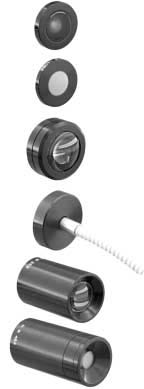
When selecting input optics for a measurement application, consider both the size of the source and the viewing angle of the intended real-world receiver.
Suppose, for example, that you were measuring the erythemal (sunburn) effect of the sun on human skin. While the sun may be considered very much a point source, skylight, refracted and reflected by the atmosphere, contributes significantly to the overall amount of light reaching the earth’s surface. Sunlight is a combination of a point source and a 2π steradian area source.
The skin, since it is relatively flat and diffuse, is an effective cosine receiver. It absorbs radiation in proportion to the incident angle of the light. An appropriate measurement system should also have a cosine response. If you aimed the detector directly at the sun and tracked the sun's path, you would be measuring the maximum irradiance. If, however, you wanted to measure the effect on a person laying on the beach, you might want the detector to face straight up, regardless of the sun’s position.
Different measurement geometries necessitate specialized input optics. Radiance and luminance measurements require a narrow viewing angle (< 4°) in order to satisfy the conditions underlying the measurement units. Power measurements, on the other hand, require a uniform response to radiation regardless of input angle to capture all light.
There may also be occasions when the need for additional signal or the desire to exclude off-angle light affects the choice of input optics. A high gain lens, for example, is often used to amplify a distant point source. A detector can be calibrated to use any input optics as long as they reflect the overall goal of the measurement.
Cosine Diffusers

A bare silicon cell has a near perfect cosine response, as do all diffuse planar surfaces. As soon as you place a filter in front of the detector, however, you change the spatial responsivity of the cell by restricting off-angle light. Fused silica or optical quartz with a ground (rough) internal hemisphere makes an excellent diffuser with adequate transmission in the ultraviolet. Teflon is an excellent alternative for UV and visible applications, but is not an effective diffuser for infrared light. Lastly, an integrating sphere coated with BaSO4 or PTFE powder is the ideal cosine receiver, since the planar sphere aperture defines the cosine relationship.
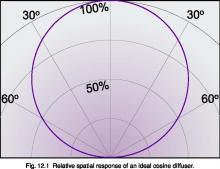
Radiance Lens Barrels
Radiance and luminance optics frequently employ a dual lens system that provides an effective viewing angle of less than 4°. The tradeoff of a restricted viewing angle is a reduction in signal. Radiance optics merely limit the viewing angle to less than the extent of a uniform area source. For very small sources, such as a single element of an LED display, microscopic optics are required to “underfill” the source.
The Radiance barrel shown below has a viewing angle of 3°, but due to the dual lenses, the extent of the beam is the full diameter of the first lens; 25 mm. This provides increased signal at close distances, where a restricted viewing angle would limit the sampled area.
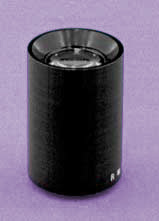
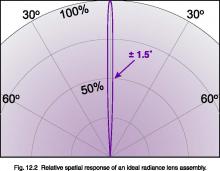
Fiber Optics
Fiber optics allow measurements in tight places or where irradiance levels and heat are very high. Fiber optics consist of a core fiber and a jacket with an index of refraction chosen to maximize total internal reflection. Glass fibers are suitable for use in the visible, but quartz or fused silica is required for transmission in the ultraviolet. Fibers are often used to continuously monitor UV curing ovens, due to the attenuation and heat protection they provide. Typical fiber optics restrict the field of view to about ±20° in the visible and ±10° in the ultraviolet.
Integrating Spheres
An integrating sphere is a hollow sphere coated inside with Barium Sulfate, a diffuse white reflectance coating that offers greater than 97% reflectance between 450 and 900 nm. The sphere is baffled internally to block direct and first-bounce light. Integrating spheres are used as sources of uniform radiance and as input optics for measuring total power. Often, a lamp is place inside the sphere to capture light that is emitted in any direction.
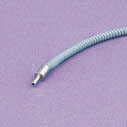
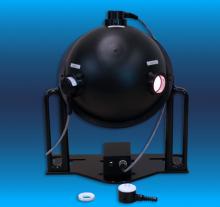
High Gain Lenses
In situations with low irradiance from a point source, high gain input optics can be used to amplify the light by as much as 50 times while ignoring off angle ambient light. Flash sources such as tower beacons often employ Fresnel lenses, making near field measurements difficult. With a high gain lens, you can measure a flash source from a distance without compromising signal strength. High gain lenses restrict the field of view to ±8°, so cannot be used in full immersion applications where a cosine response is required.
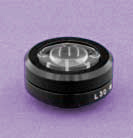

Request Light Management Handbook as PDF (ALL Chapters)
Chapter 12 - The Light Measurement Handbook
Copyright © 1997 by Alexander D. Ryer
All Rights Reserved.
No part of this publication may be reproduced or transmitted in any form or by any means, electronic or mechanical, including photocopying, recording, or any information storage and retrieval system, without permission in writing from the copyright owner. Requests should be made through the publisher.
Technical Publications Dept.
International Light Technologies
10 Technology Drive
Peabody, MA 01960
ISBN 0-9658356-9-3
Library of Congress Catalog Card Number: 97-93677
Explore more light measurement resources
- Light Meters, Lux Meters & Radiometers
- UVC Light Meters
- UV & UVC LEDs
- Light Meter Calibration
- Spectrometers & Spectroradiometers
- Light Measurement Detectors
